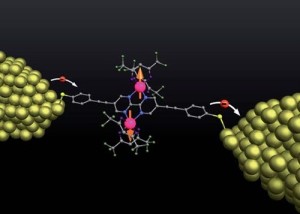Magnetism experiment successful

Nature Nanotechnology: researchers recreate elementary physics in a single molecule
Physicists from FAU and the Karlsruhe Institute of Technology (KIT) have succeeded in an unusual experiment: they were able to prove that magnetism – commonly expressed in the force between two magnetised objects – also functions within an individual molecule. This discovery, which is of great importance to fundamental research, equips scientists with new tools to better understand magnetism as an elementary phenomenon of physics. The researchers’ results were published in the journal Nature Nanotechnology on 15 July.*
The smallest unit of a magnet is the magnetic moment of a single atom or ion. If two such magnetic moments are connected, there are two possibilities: either the magnetic moments add up to a stronger moment, or they compensate each other and the magnetism disappears. In quantum physics, these two outcomes are known as triplet or singlet. A team of researchers led by Prof. Mario Ruben (KIT) and Prof. Heiko B. Weber (FAU) wanted to examine whether the magnetism of a pair of magnetic moments within a single molecule is electrically measurable.
Mario Ruben’s working group tailor-made a molecule from two cobalt ions for the experiment. Heiko B. Weber and his team then examined the molecule in Erlangen in what is known as a single-molecule junction. This requires bringing two metal electrodes so closely together that the molecule – which has a length of about two nanometres – can be held stably between them for many days, with the junction allowing electricity to be measured at the same time. The scientists then exposed this experimental set-up to various temperatures, including extremely low ones.
It turned out that magnetism can be measured in this way: the magnetic state within the molecule manifested as a Kondo anomaly, an effect that causes electric resistance to decrease with sinking temperatures. It only occurs when there is actually magnetism – and thus serves as proof. At the same time, the researchers were able to switch this Kondo effect on and off using the impressed voltage. An accurate theoretical analysis in the working group carried out by PD Karin Fink (KIT) defines the various complex quantum states of the cobalt ion pair more closely. Researchers have thus been successful in recreating elementary physics in a single molecule.
*DOI: 10.1038/nnano.2013.133
Further information:
Prof. Dr. Heiko B. Weber
Phone: + (0)9131 85 28421
heiko.weber@physik.uni-erlangen.de